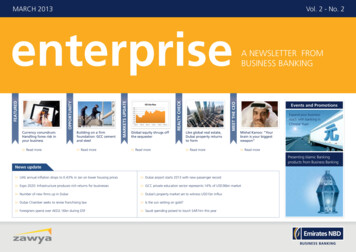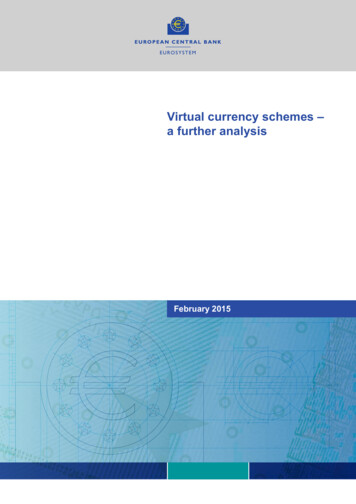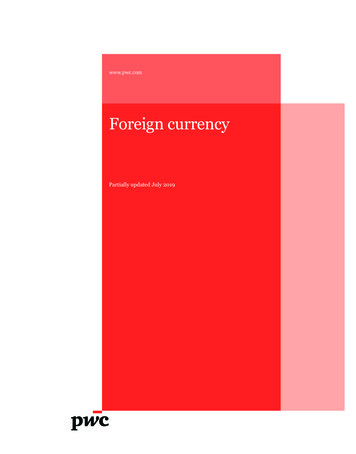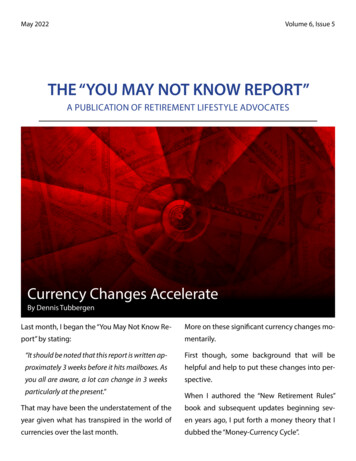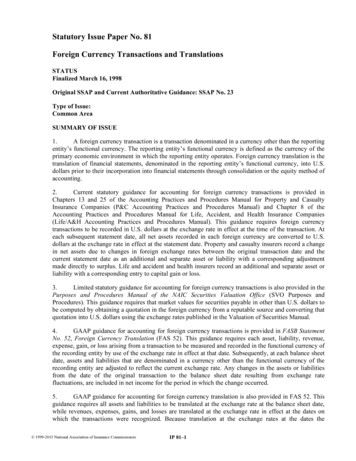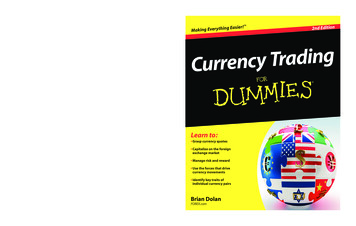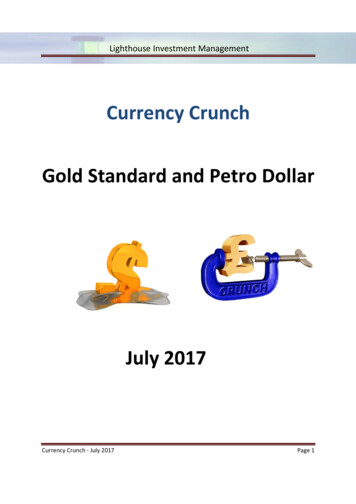
Transcription
Lighthouse Investment ManagementCurrency CrunchGold Standard and Petro DollarJuly 2017Currency Crunch - July 2017Page 1
Lighthouse Investment ManagementContents1944: Bretton Woods and the Gold Standard . 31965: French want Gold . 41966: Foreign Liabilities Rise. 41968: Balance of Payments Deteriorates . 41970: Money Supply and Inflation Accelerate . 51971: End of the Gold Standard (“Nixon Shock”) . 6Smithsonian Agreement . 6Aftermath . 71973: Yom Kippur War and Oil Embargo . 91974: The Petro-Dollar; Nixon Resignation . 12End of Petro-Dollar . 15US Twin Deficits. 16Currency Crunch - July 2017Page 2
Lighthouse Investment Management1944: Bretton Woods and the Gold StandardAfter World War 2, the US owned over half the world’s official gold reserves. This gave the US the upperhand at Bretton Woods1 (1944): most other currencies had to peg to the US dollar. As the US dollar wasin turn pegged to gold at 35 per ounce, the world economy was on a de-facto gold standard.However, a negative balance of payments, growing debt by Vietnam War (1955 – 1975) and monetaryinflation by the Federal Reserve led to an over-valuation of the dollar.1The Bretton Woods Conference, formally known as the United Nations Monetary and Financial Conference, was agathering of 730 delegates from all 44 Allied nations at the Mount Washington Hotel in Bretton Woods, NewHampshire, to regulate the international monetary and financial order.Currency Crunch - July 2017Page 3
Lighthouse Investment Management1965: French want GoldFebruary 1965: France was not happy with “America’s exorbitant privilege” where non-US citizenssupported US standard of living and subsidized US multinationals. In February 1965, French President DeGaulle announced he would exchange France’s dollar reserves for gold and sent war ships to pick up thegold.1966: Foreign Liabilities RiseBy 1966, non-US central banks held 14 billion in US dollars while the US had only 13.2 billion in goldreserves (of which only 3.2 billion was available for foreign holders as the rest was covering domesticholdings).1968: Balance of Payments DeterioratesOn January 1, 1968, President Lyndon B. Johnson announced a series of measures designed to addressthe U.S. balance of payments deficit; among the measures were new restraints on U.S. foreign directinvestment.In March 1968, the central bank governors of Belgium, the Federal Republic of Germany, Italy, theNetherlands, Switzerland, the United Kingdom, and the United States agreed to establish a two-tiermarket for gold; central bankers would continue to buy and sell gold among themselves at the officialgold price but would no longer engage in transactions in the private gold market, thus allowing theprivate market price to fluctuate.Currency Crunch - July 2017Page 4
Lighthouse Investment Management1970: Money Supply and Inflation AccelerateBy 1970, US M3 money supply had doubled over the previous ten years. Inflation accelerated to over 6%while real GDP growth stalled.Over 11 years, the US had lost more than half its gold as European economies recovered from the warand began to collect their positive trade balances in gold.Gold prices were already trading above 40 in 1968 and 1969. But due to the gold peg, foreign centralbanks were able to buy gold from the US Treasury at the fixed price of 35.In a last-ditch attempt, gold prices were suppressed to near 35 (December 1969 to August 1970). Butthe outflow of gold continued. Gold prices rose again to 39 (October 1970) and above 43 on Friday,August 13, 1971.Currency Crunch - July 2017Page 5
Lighthouse Investment Management1971: End of the Gold Standard (“Nixon Shock”)Sunday, August 15, 1971 (“Nixon Shock”): President Nixon announced to “temporarily suspend” theconvertibility of the US dollar into gold (still the case 46 years later), a 90-day freeze on wages in orderto counter inflation and a 10% surcharge on imports. Nixon tried to assure Americans not much wouldchange for them:“Now, what is this action—which is very technical—what does it mean for you? Let me lay to restthe bugaboo of what is called devaluation. If you want to buy a foreign car or take a trip abroad,market conditions may cause your dollar to buy slightly less. But if you are among theoverwhelming majority of Americans who buy American-made products in America, your dollarwill be worth just as much tomorrow as it is today. The effect of this action, in other words, willbe to stabilize the dollar.”2The US stock market applauded this de-facto devaluation of the US dollar, with the Dow Jones Indexrising 33 points – the biggest daily gain ever at that point. The New York Times editorial marveled:“We unhesitatingly applaud the boldness with which the President has moved.”Smithsonian AgreementIn December of 1971, the US tried to save the Bretton Woods monetary system. President Nixon andFrench President Pompidou held a summit meeting in the Azores December 13–14, 1971, where theylaid the foundation for the monetary agreement at the Smithsonian Institution later that month.The US dollar was devalued by 8% relative to gold (by raising gold price from 35 to 38 per ounce).Other G103 countries were forced to appreciate their currencies at the same time so that the US dollarsdepreciation added up to 17% versus the Japanese Yen and 14% versus the Deutschmark. Trading bandsof 2.25% were introduced.The G10 also announced a plan to balance the global financial system using special drawing rights (SDR),however failed to come up with any actions.In June 1972, the British Pound had to let go onto free float.23“Address to the Nation Outlining a New Economic Policy”, by: Richard Nixon, August 15, 1971G10 Belgium, Canada, France, Germany, Italy, Japan, Netherlands, Sweden, Switzerland, UK, USACurrency Crunch - July 2017Page 6
Lighthouse Investment ManagementAftermathDe-pegging the US dollar from gold had serious economic repercussions in the US as well as world-wide: Despite Nixon’s assurances, the dollar lost 66% of its purchasing power due to rampant inflationover the 14 years following the end of the gold peg; it lost more than 50% against theDeutschmark.Gold prices rose exponentially from 35 to 843Crude oil prices rose from 3.56 per barrel in 1971 to 10.11 in January 1974 and to 39.80 in1980.US inflation reached 14.5% in 1980. Fed chairman Paul Volcker had to raise interest rates to 20%in order to cool down the economy in order to get a grip on inflation. Exorbitant interest ratesled to back-to-back recessions (1980 and 1981/2) as well as a strengthening dollar.The dollar got so strong that Finance Ministers had to agree to weaken it in 1985 (Plaza Accord).It subsequently got so weak that it needed support only two years later (Louvre Accord).Currency Crunch - July 2017Page 7
Lighthouse Investment ManagementCurrency Crunch - July 2017Page 8
Lighthouse Investment Management1973: Yom Kippur War and Oil EmbargoTreasury Secretary Shultz, in conversation with Nixon in February 1973:"But at any rate, we've got to see what happens in Bonn, and so on. And, maybe they will agreeto our deal, and maybe they won't. If they don't, then, you remember, our plan is to just goahead and make a unilateral announcement that we think the exchange rates are not in line,and make a statement to the IMF along those lines and say, 'We're not going to do anything thatwill try to hold exchange rates that we think are obsolete.' And that will just cause the marketsto go absolutely nutty [laughs], and I think it will force their hand. It will be acrimonious. It willnot be as good as having worked it out, but we're in the position of saying, 'Look, we tried towork it out with you. And if—we have done this minor intervention ourselves'—and I took quite abeating on that yesterday—but the purpose of doing it is to be able to say to the Germans, 'Look,this thing is out of kilter. You've spent billions of dollars, and we put some money in, and we putsome good faith into this thing, and that just shows you that we couldn't stop it.' So, I think thatwe're in a good talking position that way."4The US government got more and more worried. Fed Chairman Arthur Burns warned Nixon and TreasurySecretary Shultz:“This is taking on very sizeable proportions. Since January 22nd, when it began, the outflow ofdollars amounts to 4.3 billion, and 2.6 of that has gone to Germany, and the rest is scattered.Today the Germans took in a billion and a half, so it has accelerated.”5And the government was well aware of the reason for this capital flight. Treasury Secretary Shultz:“We pretty much agree among ourselves that this speculative flurry that we now see, whether itpasses or not, is based on reality. The reality is that our trade deficit is very large— 6 billion orso this year. It has slowed down, as was expected. We expect it will go down next year. But evenso, the reality is we have a gigantic trade deficit, and we have a very large balance of paymentsdeficit, however one wants to measure it.”6What can be done? The US was going for a devaluation of the US dollar of 6.5%. Simultaneously, theJapanese should be forced to revalue their currency by the same amount (6.5%), so that the dollarwould depreciate in total 14% compared to the Yen. The Europeans would have to be discouraged tofollow the US (in devaluating), so that their currencies would appreciate compared to the dollar. Howcould the US convince their trade partners to agree to a devaluation of the dollar? One way would be to4“Conversation 853”, in: National Archives, Nixon Presidential Materials, White House Tapes, Oval Office“Conversation among President Nixon, Secretary of the Treasury Shultz and the Chairman of the Federal ReserveSystem Board of Governors, Arthur Burns”, in: Foreign Relations of the United States, 1969-1976, Volume XXXI,Foreign Economic Policy, 1973-1976, Office of the Historian6ditto5Currency Crunch - July 2017Page 9
Lighthouse Investment Managementsuggest there was a bill getting prepared in Congress which would slap punitive import duties on foreignproducts unless those countries agrees to revaluation. The other way was to threaten countries towithdraw US military ‘protection’. Burns states:“We don't have strong cards on trade, considering the way the world is organized. And, on themonetary side, well, our strong card is defense. We are protecting the world, and they know it.”7The biggest threat to US hegemony would be if there were no military threats, since an offer to ‘protect’would then be worthless. That is the reason why US foreign policy consists of creating, rather thanpreventing, military conflicts. Of course, the U.S. would never openly threaten an ally, instead usingseemingly unrelated third parties (ISIS, for example) while maintaining plausible deniability. If thirdparties are unavailable, the CIA is ready to ‘help out’:“CIA tactics were sometimes unsavory, as they included bribes, subversion, and evenassassination attempts. But Eisenhower authorized those actions, even as he maintainedplausible deniability, carefully concealing all evidence of U.S. involvement so that he could denyany responsibility for what had happened.”8One group of countries particularly unhappy about the dollar devaluation were the Arab oil exporters –they were selling their oil for dollars, which were quickly losing value.In 1973, the Shah of Iran, in an interview with the New York Times, stated his displeasure:“Of course the price of oil is going to rise. You [Western nations] increased the price of wheat yousell us by 300%, and the same for sugar and cement. You buy our crude oil and sell it back to us,refined as petrochemicals, at a hundred times the price you have paid us. It is only fair that, fromnow on, you should pay more for oil. Let’s say ten times more.”In October 1973, members of the OAPEC9 announced an oil embargo against the US, Canada, Japan, theNetherlands and the UK. This was in retaliation for US support for Israel during the Yom Kippur War(October 6-25, 1973). Oil prices were raised by 70% to 5.11 a barrel, and another 98% to 10.11 inJanuary 1974.On the surface, military tensions in the Middle East caused a rise in the oil price.However, in May 1973 (five months before Yom Kippur War and the oil embargo), 84 of the world’s topfinancial and political leaders met at Saltsjöbaden, Sweden, a secluded island resort of the Swedish7ditto“Dwight D. Eisenhower: Foreign Affairs”, by: UVA Miller Center, a non-partisan affiliate of the University ofVirginia9Organization of Arab Petroleum Exporting Countries (Arab members of OPEC Syria Egypt)8Currency Crunch - July 2017Page 10
Lighthouse Investment ManagementWallenberg banking family. It was the so-called Bilderberg Group10. An American participant, WalterLevy, proposed an immediate increase in oil prices of 400 per cent.11The repercussions of such a large rise in oil prices for oil-consuming economies were clear: aninflationary shock coupled with balance-of-payments difficulties (as non-US countries were lacking thenecessary dollars to pay for sudden increase in their bill for oil imports).That doesn’t make sense, does it? The dollar was at risk of falling apart, so “ the purpose of the secret Saltsjöbaden meeting was not to prevent the expected oil priceshock, but rather to plan how to manage the about-to-be-created flood of oil dollars, a processU.S. Secretary of State Kissinger later called ‘recycling the petro-dollar flows’.”1210Attendants (among others): Robert Anderson – Atlantic Richfield Oil, Lord Greenhill – British Petroleum(chairman), Sir Eric Roll – S.G. Warburg (creator of Eurobonds), George Ball – Lehman Brothers, David Rockefeller –Chase Manhattan Bank, Zbigniev Brzezinski – President Carter’s national security adviser, Gianni Agnelli – Presidentof FIAT and Otto Wolff von Amerongen – influential German entrepreneur and member of Exxon Oil management11“Anglo-American Oil Politics and the New World Order” by William Engdahl, 201212“Anglo-American Oil Politics and the New World Order” by William Engdahl, 2012Currency Crunch - July 2017Page 11
Lighthouse Investment Management1974: The Petro-Dollar; Nixon ResignationIn July 1974, Kissinger sent William Simon, newly appointed Treasury Secretary, to Saudi Arabia. Thegoal was to “neutralize crude oil as an economic weapon and find a way to persuade a hostile kingdomto finance America’s widening deficit with its newfound petrodollar wealth.”13“The US would buy oil from Saudi Arabia and provide the kingdom military aid and equipment. Inreturn, the Saudis would plow billions of their petro-dollar revenue back into Treasuries andfinance America’s spending.”14There was one catch:“At the end of negotiations, there remained one small, yet crucial, catch: King Faisal bin AbdulAziz Al Saud demanded the country’s Treasury purchases stay “strictly secret,” according to adiplomatic cable obtained by Bloomberg from the National Archives database.”Other Arab countries would be outraged if they learned Saudi Arabia was investing its oil proceeds in USTreasury securities, thereby helping finance their foe’s budget deficit. And so Saudi holdings were kept asecret for decades, until Bloomberg News filed a Freedom-of-Information-Act request. The TreasuryDepartment had to break out Saudi Arabia’s holdings for the first time in May 2016. The 117 billiontrove makes the kingdom one of America’s top ten foreign creditors.The Saudis would have preferred to invest proceeds from their oil sales into gold; the dollar seemed tobe not such a good store of value. But that wouldn’t help the United States. So what could be done?The US was unable to hold down gold prices. But what if the Saudis could be promised a certain gold-tooil ratio? If gold prices rose, so would oil. This way, it wouldn’t matter for the Saudis if they bought goldor Treasury bonds.Now the oil market is prone to dramatic price fluctuations as demand is (almost) insensitive to price,and so is supply (at least short-term). Consumers are not going to drive less if the oil price rises; oil wellsand offshore rigs are not going to be shut down if the oil price drops (the only thing that stops is newinvestment into exploration).So tiny demand-supply imbalances can lead to huge price swings. If the US was unable to hold goldprices down, then oil prices had to go up in order to keep the gold-oil ratio stable. And if oil supplythreatens to get out of hand? Well, nothing easier than supplying weapons to two oil-producingcountries at war (Iran-Iraq) or destroying countries entirely (Iraq, Libya, Syria).13“The Untold Story Behind Saudi Arabia’s 41-Year Debt Secret” by Andrea Wong, in: Bloomberg News, May 31,201614“The Untold Story Behind Saudi Arabia’s 41-Year Debt Secret” by Andrea Wong, in: Bloomberg News, May 31,2016Currency Crunch - July 2017Page 12
Lighthouse Investment ManagementThis agreement worked more or less until summer 2014, when Saudi Arabia was unwilling to cut oilproduction in order to balance the oil market. But why? Why wouldn’t you rather sell 9 million barrelsper day (instead of 10 million) at 100 per barrel (for revenues of 900m per day) instead of 10 millionbarrels at 50 (for revenues of 500m per day)? The answer lies in alternative energy and electricvehicles.The future of oil is not that bright, according to Sheik Yamani, the former Saudi oil minister:“Thirty years from now there will be a huge amount of oil – and no buyers. Oil will be left in theground. The Stone Age came to an end, not because we had a lack of stones, and the oil age willcome to an end not because we have a lack of oil.”15What does he mean by that?“The Stone Age didn’t end because people ran out of stones – it ended because we learned tocontrol fire and to forge bronze tools. Accordingly, the oil age will end because of technologicalprogress; oil will be substituted by some better source of energy.”161516“Sheikh Yamani predicts price crash as age of oil ends”, by Mary Fagan, in: The Telegraph, June 25th, 2000“Victor the Cleaner” via TwitterCurrency Crunch - July 2017Page 13
Lighthouse Investment ManagementYamani predicts that a combination of recent oil discoveries, the advance of new technology, and heavyinvestment in exploration and production will all lead to a collapse in the price of crude oil as electricvehicles will cut gasoline consumption by almost 100 per cent.“Imagine a country like the United States, the largest consuming nation, where more than 50 percent of their consumption is gasoline. If you eliminate that, what will happen? In the longer term,no one will need oil.”17Assuming his views are accurate, some crude oil will remain in the ground. The question is, whose oilwill it be? And the answer lies in the price of production. As producers of cheap oil (Middle East)attempt to maximize their output, the oil price will fall, and producers of expensive oil (shale oil,fracking, deep off-shore) will become unprofitable and forced to close down operations. Market sharewill move towards those producers with the lowest production cost. That would be the Middle East andRussia (Rosneft CEO claimed his costs were 2.10 per barrel). Oil production in high-cost locations (likethe US) will only be able to survive if oil prices in dollars will remain high (while oil in Euros will fall). Thiswould make a significant fall in the US dollar necessary.17“Sheikh Yamani predicts price crash as age of oil ends”, by Mary Fagan, in: The Telegraph, June 25th, 2000Currency Crunch - July 2017Page 14
Lighthouse Investment ManagementEnd of Petro-DollarThe Saudis saw how the US was struggling to prevent the gold-to-oil price ratio from rising above 15. Inthe late 1990’s it became clear the birth of the Euro would offer a better alternative to the US dollar.Aging Saudi King Abdullah was preparing to cut loose the US dollar and switch to the Euro. Then 9/11happened. Fifteen of the nineteen hijackers were of Saudi nationality. According to FBI documents,several Saudi Naval officers had been in contact with the hijackers. The Saudi ambassador’s wife to theUS wired money to some of the hijackers.Yet despite overwhelming evidence, it was not Saudi Arabia the US attacked after 9/11 – insteadAfghanistan (October 2001) and Iraq (March 2003) were invaded.28 pages of the report by the 9/11-Commission implicating Saudi connections to the hijackers werewithheld from the public for 14 years. The Saudis threatened to sell their US Treasury bonds if the USwere to publish the entire report and allowing 9/11 victims to sue the Saudi royal family for damages. Inreturn, the US changed the way it reported foreign holdings of US Treasury securities, showing for thefirst time ever how many were held by Saudi Arabia (and it was much less than commonly believed).Saudi Arabia realized that high oil prices have attracted huge investment into shale oil in the US, whichallowed the US to come close to a net energy exporter for the first time in 2015. High oil pricesencourage investment into alternative energy sources and hence eat into Saudi market share.So Saudi strategy changed. The aim is now to produce and sell as much oil as possible even if it meanssignificantly lower oil prices. If US shale oil and offshore drilling is destroyed in the process – evenbetter.Now this poses a problem for the US. A world where non-US countries consume 80 million barrels of oilper day need 8 billion at 100 oil, but only 4 billion at 50 oil. Demand for US dollars to pay for oilimports invoiced in dollars just halved. Less dollar revenue for oil-exporting countries also means lesspurchases of US Treasury bonds. Furthermore, some countries are moving away from dollar invoicing foroil. In December 2007, Iran stopped selling any oil for US dollars.18 In October 2000, Iraq announced aswitch from selling oil for dollars to Euros19. In March 2003, the US invaded Iraq. In December 2002,North Korea officially dropped the dollar and begun using Euros for trade. OPEC was prepared to switchto Euros from US dollars, but such a move was vetoed by Saudis after being pressured by US.20 Bydestroying Iraq, the US gained 15 years of artificially high dollar oil price in order to develop their ownnonconventional oil. But as Iraq rebuilds, production will come back.18“Iran stops selling oil in US dollars” by Reuters, December 8, 2007“Iraqi Oil Sales to Switch from Dollars to Euros” by Stratfor Worldview, October 30, 200020Source: Iran OPEC representative according to Chris Cook, Senior Research Fellow at the Institute for Securityand Resilience Studies at University College London. Cook was director at the International PetroleumExchange IPE.19Currency Crunch - July 2017Page 15
Lighthouse Investment ManagementUS Twin DeficitsThe US has enjoyed the privilege of running twin deficits without having to fear a collapse of itscurrency. Dollars were needed to pay for oil imports; oil-exporting countries recycled their petro-dollarsinto US Treasuries, thereby helping fund the massive military spending.However, the US’s foreign military intervention have become more and more expensive; the 16-year“War on Terror” syphoned an estimated 4.8 trillion from US taxpayers.So the US have reached an impasse: military adventures to keep a lid on oil production becomesprohibitively expensive; more and more oil exporters move away from invoicing in US dollars and the oilprice is falling. The US has lost control over the gold-to-oil ratio.Foreign central banks have begun reducing their US dollar holdings. The next recession will lead toexploding US fiscal deficits. There will be no other buyer left than the Federal Reserve. As the Fed mightbe able to avoid a crash of the bond market, the adjustment must come via the exchange rate. This isthe beginning of the end of the Petro-Dollar. A significant devaluation of the US Dollar is to be expected.We will see the Euro becoming twice as valuable as the Dollar (currently 1.14).Currency Crunch - July 2017Page 16
Lighthouse Investment ManagementAny questions or feedback welcome.Alex dot Gloy at LighthouseInvestmentManagement dot comDisclaimer: It should be self-evident this is for informational and educational purposes only and shall not betaken as investment advice. Nothing posted here shall constitute a solicitation, recommendation orendorsement to buy or sell any security or other financial instrument. You shouldn't be surprised thataccounts managed by Lighthouse Investment Management or the author may have financial interests in anyinstruments mentioned in these posts. We may buy or sell at any time, might not disclose those actions andwe might not necessarily disclose updated information should we discover a fault with our analysis. Theauthor has no obligation to update any information posted here. We reserve the right to make investmentdecisions inconsistent with the views expressed here. We can't make any representations or warranties as tothe accuracy, completeness or timeliness of the information posted. All liability for errors, omissions,misinterpretation or misuse of any information posted is excluded. All clients have their own individual accounts held at an independent, well-known brokerage company (US)or bank (Europe). This institution executes trades, sends confirms and statements. Lighthouse InvestmentManagement does not take custody of any client assets.Currency Crunch - July 2017Page 17
1971: End of the Gold Standard ("Nixon Shock") Sunday, August 15, 1971 ("Nixon Shock"): President Nixon announced to "temporarily suspend" the convertibility of the US dollar into gold (still the case 46 years later), a 90-day freeze on wages in order to counter inflation and a 10% surcharge on imports.
